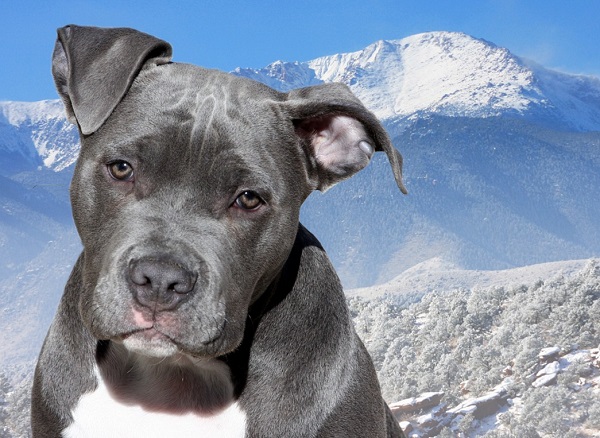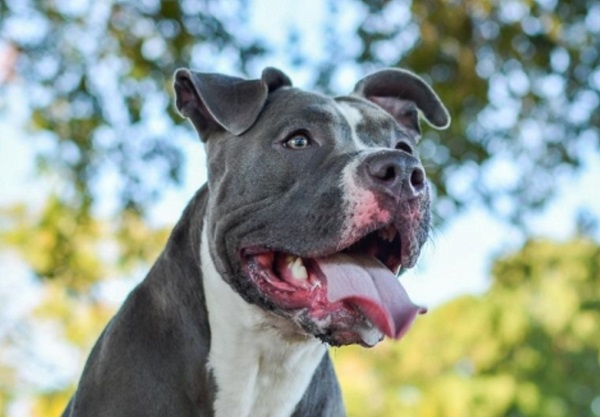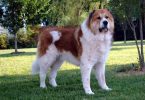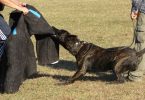The Blue Nosed Pit bull is a beautifully built animal: muscular but not overly masculine, with a smile that resembles that of a shark but without all the Jaws-induced terror. They have eyes that smile relentlessly at you. Often sporting a grey coat with patches of white across its face and body, the Blue Nose is a heart warming and cheerful animal.
These dogs have become increasingly popular in recent years, particularly as puppies, primarily due to their acceptance of discipline and responsiveness while being trained. These are just some features in a long list of reasons as to why the Blue Nose Pit bull is a highly intelligent animal.
They have almost human-like emotions, which make them incredibly relatable to their owners. They form strong and lasting familial bonds with both their owners and other pit bulls, in a similar way to dolphins, orcas and penguins. They are incredibly loyal to their pack, though not all that protective, thus making them relatively poor guard dogs.
Children and Blue Noses make good friends. Most dogs are a good tool for developing companionship in kids, and also for teaching them at a younger age about life and death. However, kids tend to be quite unintentionally rough with pets, tugging tails, tackling to the floor and such.
But Blue Noses are strong enough and revel in the rough and tumble, while also knowing its boundaries and the limit to which they can ‘fight back’. They have a high tolerance to pain, due to their unfortunate history of being bred for blood sport, a truth that thankfully exists a lot less now.
A Bit of History
Pit bulls are believed to have been used as fighting dogs long before blood sport emerged. In fact, as far back as 50 AD, when early Britons adopted a variation of the Molossian dog family, pit bulls have demonstrated their loyalty to their owners. Roman Emperor Claudius was so impressed by the dogs that he shipped many back to Rome where they were crossbred with Roman counterparts, and from 50 AD to 410 AD, the dog was dispersed throughout the Roman Empire and used as a fighting dog. The long term mixed breeding with indigenous dogs throughout Europe led to a genetic melting pot of bulldogs, which are believed to be the direct descendants of the American pit bull.
It was the Normans, around 1086, which introduced the sport ‘baiting’ upon invading Britain. Butchers, while moving bulls, would set their dog upon the bull, which would clamp down on its nose until either the bull became submissive or flung the dog into the air, often killing it. By the 16th Century, almost every town in Britain had its own baiting ring, or pit, possibly shedding light on how the pit bull got its name. The popularity of the sport was unparalleled until the British government rendered it unlawful as late on as 1835.
However, the public’s desire for blood sport remained strong and illegal, dog fighting remained a popular event due to the ease of keeping the spectacle hidden from public eyes. Since dog fighting required smaller and more agile animals, bulldogs were bread with smaller, feisty terriers, resulting in what is known as the first pit bull terrier: a muscular gladiator bred specifically to combat other dogs in these illegal Coliseums.
Obviously this was a cruel and sadistic pursuit, and the life of the early pit bull was confined to one of minimal human contact and a deeply sewn desire to attack and spill the blood of any opponent. Their diet consisted of blood and raw meat, and they were confined to darkness outside of their training time or until their time to fight in the ring.
Any sign of fear or weakness in the ring doomed the dog. If it were lucky enough to survive its fight, the owner would usually kill the dog himself because he believed the dog was unreliable and unfit to fight again with the ferocity required for the hideous sport.
English emigrants brought their dogs with them to America, and throughout the 19th Century dog fighting was popular in the States. However, in 1884 the American Kennel Club was established to promote the interests of purebred dogs and their owners. Initially the American Kennel Club rejected pit bulls as purebred, also sighting the reason for their breeding, illegal fighting, as a concern.
The United Kennel Club was set up in 1898 in order to promote dogs rejected by the American Kennel Club, the pit bull terrier becoming a primary benefactor in this. Since then, the pit bull has gone on to symbolize many aspects of Americana. In fact, they were so respected in America during the early 1900s that the face of a pit bull terrier was used to American propaganda posters during the First World War.
A pit bull named Stubby became the unofficial mascot of the 102nd Infantry Division. Stubby was credited with saving the lives of several soldiers during his time at war. He won several medals and was even awarded the rank of sergeant.
Despite the horrendous history of pit bulls terriers and blood sport, pit bulls are naturally friendly, caring dogs. Unfortunately the modern dog still carries a bad reputation, but they aren’t dangerous animals and they’re slowly becoming a favoured icon of America once again.
The modern pit bull is bred to be loving, family companions. This is not to say that they’re perfect. Any neglected, mistreated or abused dog has the potential to be aggressive, especially one as intelligent as the Blue Nose, and one with near-human emotions.
Thankfully, many notable Americans have owned pit bulls, which has eased their modern reputation, along with stories of heroics, such as Stubby. Mark Twain, Theodor Roosevelt, Helen Keller, Thomas Edison, Humphrey Bogart and John Steinbeck, to name a few, all owned pit bulls and would be considered some of the finest Americans to have lived.
Caring for Your Pit Bull
Exercise
Training and socialization is key to ensure a pleasant dog of any breed, and the Blue Nose is no exception. If you’re not the type to get out with your dog at least once a day, then don’t consider purchasing a Blue Nose. They need at least a walk a day, preferably with the freedom to run around in an open space off the leash. A good level of playtime is also advisable. A lack of exercise will inevitably lead to a dog dealing with psychological and physical baggage. They have the potential to become overweight, lazy and lethargic. This can also lead to a bored and potentially dangerous dog. Again go back to the idea that these animals have human-like emotions and put yourself in a position whereby you’re stuck indoors, against your will, for days on end.
Diet
Maintaining a happy dog begins with its diet. Pit bulls are tough and will survive of just about anything you feed them. But you don’t want your dog to simply “survive”, do you? Of course you don’t. You want it to thrive, become strong, healthy and even huge. It’s important to feed your pit bull a high-protein, low-grain dog food, with meat as the primary ingredient.
The problem with most American dog foods is that they use predominantly corn, with potato and wheat as fillers. This is no good for any dog, and certainly not a pit bull. The best thing you can do is feed your pit bull meat. However, that does get expensive. So try to mix raw meat into its regular food, which should be of a high quality, but not too expensive as they have gigantic appetites. Bones from your butcher are also a good idea, as the marrow provides them with a lot of extra protein.
The best dry food you can give your pit bull is Orijen dog food. Most dog food brands aim to use the minimum requirements to meet a certain standard. Orijen takes those quality standards and amplifies them to admirable proportions. This company raises their own free-range chickens and sends out their own fishermen to catch fresh salmon to provide your pit bull with the freshest meat they can provide for your dog.
The ingredients are fantastic, and so too are the proportions. Each bite contains 80% protein for your pit bull, providing it with the necessary protein intake to develop healthily and strongly. Although expensive at about $80 for a 28. 6 lb bag, the lack of filler in Orijen’s dog food means that your pit bull will only eat 30 to 40 pounds a month.
If you are looking for something a little cheaper, try Taste of The Wild brand of dog food. Their food also contains quite high protein intake of both meat and meal. Aside from high protein, Taste of The Wild uses also acidophilus and fermented solubles to help with your pet’s digestion.
Taste of the Wild lists all of their food ingredients on their labels so you know exactly what your pup is eating.
For those of you thinking of purchasing a pit bull puppy, the best you can get is The Blue Wilderness Puppy food. Their food is grain free and great for your pit puppy. You cannot cut corners on a pit bull puppy. So just bite the bullet and go all out of giving your pup the best possible start in life. This is a pivotal stage of your dog’s development and you should take responsibility at this point more than ever.
The Blue Wilderness Grain Free Puppy Food has everything your pit bull puppy is going to need. It provides DHA, a fatty acid that pups will get from their mother’s milk. It also has boned chicken and turkey and chicken meal for a high protein formula. You won’t find a blend which scores higher in clinical tests. This stuff is based on the diet of wild wolves and is certain to give your pit bull pup optimum satisfaction.
The Health of Your Blue Nose
Size and weight
Health standards of pit bulls in general apply to Blue Noses as well. Their average height or weight is not very important, but rather their proportion of weight to height is what you should take note of. A pit bull of 14 to 24 inches high should weight between 22 and 78 pounds. There are some extra health considerations you might want to take note of.
Diseases
Mange, alopecia, cataracts, heart problems and neurological disorders are more likely to arise in Blue Noses. This is primarily down to breeders inbreeding their pit bulls in order to increase their chance of providing a Blue Nose. However, don’t be discouraged: a healthy lifestyle and tentative maintenance significantly reduce the risk of your pit bull encountering some or any of these problems.
Color
Usually, Blue Nose pitbull’s skin has a gray shade. This is an outcome of a recessive gene that causes a lack of black skin and fur pigment. In order ro accomplish that, both breeding parents need the recessive gene. This particular pigment gene causes decreased melanin production, especially in black pigment. The lack of pigment causes the dog’s skin and fur become diluted which produces a gray shade.
Depending on the amount of pigment that goes into the skin, your pibull may show a darker charcoal gray skin. This effect is caused when more pigment has found its way to the fur and skin. However, your pitbull may have a lighter silver gray skin if it has less pigment. The skin color difference is pretty noticeable on the places like the pitbull’s gums, nose, under the stomach and fur.
The fascinating coloring of the nose pit is very rare on Blue Nosed pit bulls, which is why breeders are often found guilty of inbreeding. Not all Blue Nose pit bulls have a blue nose pit, yet they are still a Blue Nosed pit bull. Many breeders will tell you that the Blue Nose is a rare or different breed or bloodline, and try to sell the dogs at extortionate prices. Do not listen to this. It is not true. Blue Nosed pit bulls are a regular pit bull breed, some have a blue nose pit and others don’t. Some have a red nose pit and some have only a partially blue nose pit. But these are still considered a Blue Nosed pit bull.
Hygiene
In terms of hygiene, Blue Nosed pit bulls sweat. A lot. So look after them, for your sake as much as theirs, and bathe them often enough. They’ll love you even more for it. They have a beautiful coat, which you should brush with a firm bristled brush as necessary. Dry them off with a towel to make their coat shine.
Life span
A healthy pit bull can live as long as 12 years. Most, however, usually make it to about 8 or 9 years. A Blue Nosed pit bull will carry the same life expectancy as the average pit bull terrier, despite it being more likely to develop health issues, so long as it’s cared for. This goes a long way in fending off the potential pit falls developed by inbreeding practices. Frequent exercise and a healthy diet is enough to fend off heart problems. And this will also go a long way to help preventing and sort of immune disorders or neurological disorders.
Here is a cute video of Blue Nose pitbull puppies:
Conclusion
Pit bulls have gone through so much in their history, from battling alongside the Briton forces and the Roman Army across Europe and being pitted again giant beasts for entertainment by the Normans, to being forced to fight one another for blood sport. Thankfully, they have been cared for in more recent history, and rewarded for their intelligence and the love and affection they now provide millions of happy owners with.
So remember, if you’re thinking of making the move to get a Blue Nosed pit bull, give it the best start in life with the correct diet, care and attention that it deserves. A high protein diet along with frequent exercise will build a healthy, happy dog. But they need more than that. Show them the care you would to any other member of your family. Dogs of all breeds think and work within packs, so include them in your one. Pit bull terriers are so intelligent, and you’ll receive the same affection and care from your Blue Nose pit bull terrier that you give it.
References:
http://americanbullydaily.com/pit-bull-dogs/blue-nose-pit-bull-breed-info/










My full-blooded American bulldog just died, which was my therapy dog for PTSD and chrons disease.And I desperately NEED one.. What’s bottom$$..Where are you located